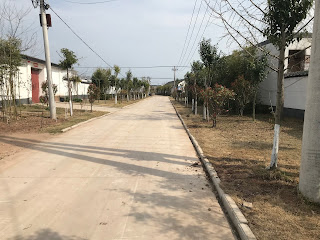March 23rd - Super Hot and Forms
 |
| 张庄 - a small village from yesterday's exploration |
Evening Thoughts 🍵
Today was a tough day of training, not only was the weather super hot but it was also just a rough day of training basics, forms, and an interesting Sanda class.Forms - 套路 - 🥋
I want to talk about these for a little bit because my view on them has changed while I've been studying at this Kung Fu School. Before, I believed forms were just a silly thing used for competitions or a different way of teaching basics to new students. I really didn't like them and as my eyes turned towards the more "combat sport" arts of Muay Thai, MMA and Boxing my thoughts about forms became more negative. So when I decided to study Kung Fu I kinda loathed the idea of studying the forms because Kung Fu has a lot of Forms.Now, I value forms as an effective training tool if taught and trained correctly. But first, what is a form? In Chinese Kung Fu the word for "form" literally means "a set of roads" as when you perform a form your steps make up "roads" and you connect all of these roads into a "set" creating the form. There are many ways to do a form, the first and most obvious is to do the whole form from the beginning to the end. This is the most basic way of studying a form, according to Master Peng, the least helpful for the student but performing the whole form does let you find your problems. That is where the other ways to practice come in. Another way is to take one movement or one part of the form and drill it. Focusing on the details like power, balance, breathing, rhythm, internal connections, external connections and more. Once you've practiced that part plenty you can move on to the next part or return to doing the whole form and see if you have improved (usually you do).
Another way to practice is to do/learn the applications of the moves that are within the form. Many people do forms by just going through the motions but when you tell someone the way to actually use the move; you give that person a small bit of understanding that changes how they perform that move in the form. You can watch two people perform the same form and wonder why they do it differently and usually the difference is they have a different understanding of the movements. Or sometimes, they just have a different... Rhythm.
Changing the rhythm or way you do the form is another way to practice. For someone that always goes super fast through the movements, having them go slower will let them focus on the details. For someone that goes too slow, they will be able to exert more energy if they go faster. You can change the way and rhythm in so many different ways because it is not just your speed but also how you do it. Your expression, your pauses, how you connect the moves and so much more.
Personally, Forms class is one of the toughest classes here. I'm always sweating, always challenging myself and always tired afterwards. It can be a great workout anywhere because you don't need equipment. You just need your body, your mind, and a place to practice. And I think this realization also taught me something; that just because something looks easy/useless that something might require quite a lot of skill and time.
Sanda Class - 散打课 - 🥊
I was nervous for Sanda Class as, if you read previous posts you'd know, I'm not the best at it. Normally it is a hard workout too that challenges muscles I don't use often. But, today Master Yan was gone so most of us were expecting Master Peng to teach but he didn't. He had us review what we had learned last week in Sanda class which was the spinning back kick. So we did that. Even though Master Yan wasn't there I still was tired after the class, part of it was due to the hot weather which has been sapping all of our energy.The rest of the day was spent reviewing and practicing Broadsword techniques.
Hope you're all doing well on this really warm Monday.
 |
| Seize the Day |

Comments
Post a Comment